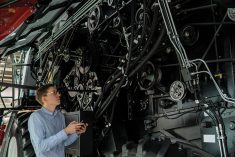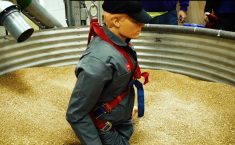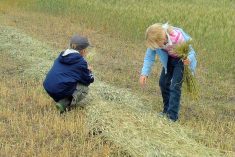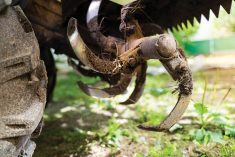Every harvest, collisions between farm equipment and passenger vehicles result in expensive repairs, injuries and sadly even deaths. However, by taking time to discuss how to safely transport agricultural equipment, farmers and equipment operators can minimize the risk of a collision.
Glen Blahey is a Health and Safety Specialist with CASA. “There are three common types of collisions involving farm equipment and a typical road vehicle: Rear-end, passing and left-turn collisions.”
A typical tractor travels less than 40 kilometres per hour. Farm machinery is long and wide. Motorists can underestimate the length, width and speed of farm machinery, often with disastrous results. Rear-end collisions occur when motorists come up on farm equipment too quickly. Passing collisions often occur because motorists attempt to pass without having a clear view of oncoming traffic. Left-turn collisions happen because motorists often think the equipment operator is pulling over to allow the vehicle to pass but the operator is actually making a wide left turn.
Read Also

Gentle treatments for pain in the neck
Heading toward year-end, people unknowingly tense up against the cold and busyness, causing neck pain that can often be treated with appropriate support and gentle mobility, athletic therapist Kathlyn Hossack says.
- From the Manitoba Co-operator: Moving equipment is a high-risk operation
What can farmers do to prevent collisions? The first step is having a conversation with all equipment operators and truck drivers about how to safely and efficiently move farm machinery on public roadways.
In March, the Canadian Agricultural Safety Association (CASA) and the Canadian Federation of Agriculture launched “Let’s Talk About It!” a Canadian Agricultural Safety Week campaign focused on encouraging farmers to talk about farm safety. As a part of the campaign, CASA developed the Toolbox Talks, a series of brief, informal talks that help farmers discuss with their workers and their families about safely conducting farm tasks.
Some quick and easy tips to remain safe:
Be Visible. If motorists know slow moving farm machinery is on the road, and how that machinery is likely to move, the chance for a collision is reduced. A Slow Moving Vehicle (SMV) emblem is a triangular, bright-orange sign with a red border. It must be placed at the centre or to the left of centre of all slow moving farm vehicles and equipment. Make sure the SMV emblem is clean and visible. Lighting is also important. Tractors and other self-propelled equipment must have at least two headlamps visible from the front, two red tail lamps visible from the rear and two flashing amber warning lamps visible from both the front and the rear of the machine. Proper turning signals should be available and used at all times. Some provinces have other lighting requirements, check with your provincial department of transportation.
Be Cautious. When operating farm machinery on a public road, drive as far to the right as possible to give motorists room to pass, but stay on the road. Travelling on the shoulder presents its own hazards — it may be soft or have obscured hazards like culvert openings or depressions. Equipment operators should never allow extra riders on farm machinery. If something goes wrong, the extra rider is the most likely person to die. And always remember to buckle up your seat belt.
Be Alert. Only properly trained and licensed drivers should ever operate farm machinery. While it goes without saying that no one should ever operate farm machinery under the influence of drugs or alcohol, it’s also true that anyone who is overly tired should also avoid driving.
Farm workers following these guidelines minimize the chance of a collision. CASA wishes all farmers a safe, healthy and productive harvest season.
For more information on Toolbox Talks, visit agsafetyweek.ca. Do you have any questions about safety? Contact CASA at [email protected].















